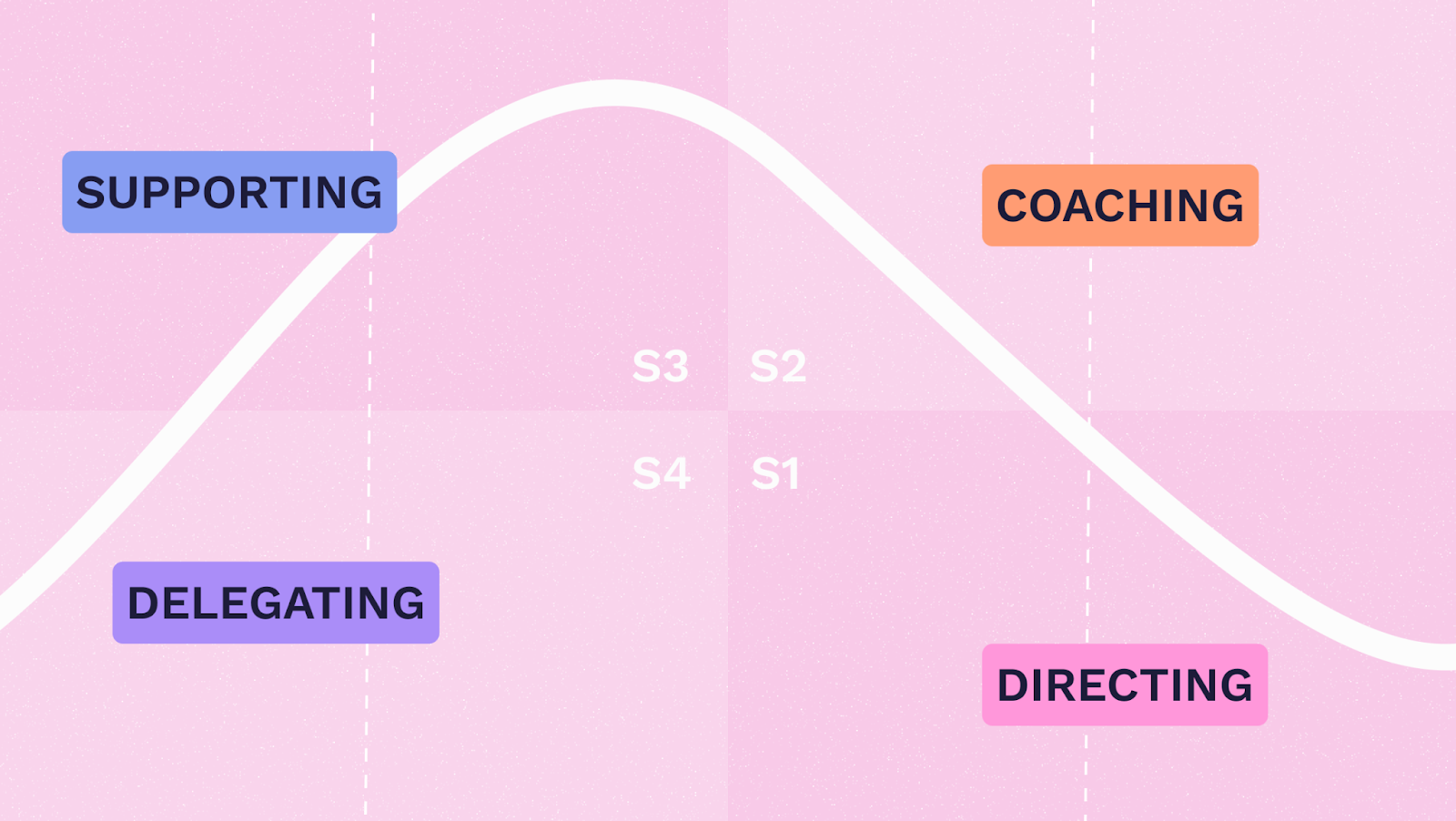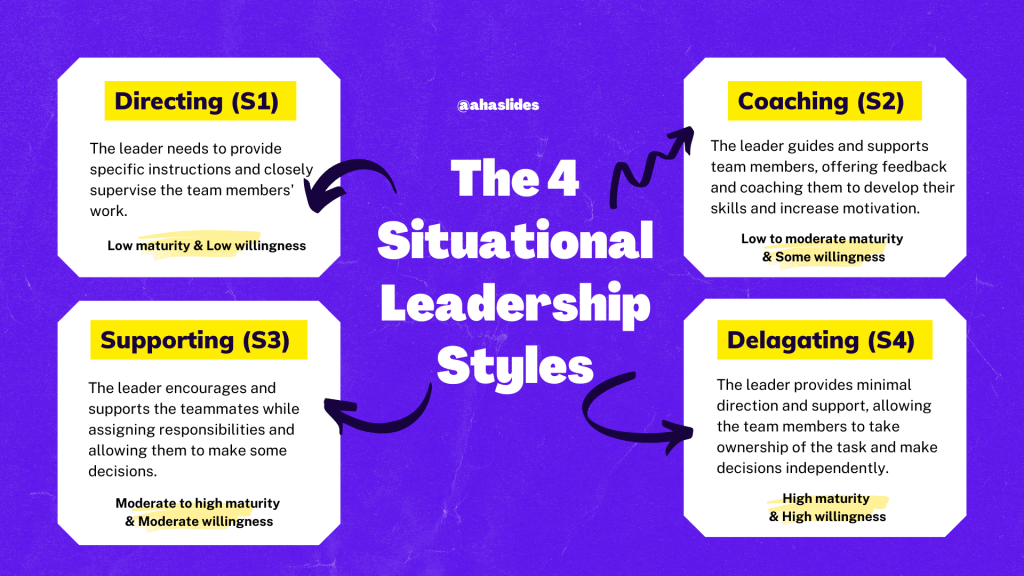The Hersey-Blanchard situational leadership theory identifies four primary styles of leadership: directing, coaching, supporting, and delegating. These leadership styles are part of the larger situational leadership model in which the optimal style is determined by the task's complexity and the team's developmental level. This model emphasizes relevant competencies of leadership such as directive behavior or supportive behavior, subsequently promoting leadership development that will be centered on a contingency-based leadership model. The decision about which type to use then becomes based on several factors, among them the task behavior and relationship behavior of the members of the team.
Introduction to situational leadership
Situational leadership is premised on the belief that leaders should change their style based on the skills of their team and the tasks they are attempting to accomplish. Professors Paul Hersey and Ken Blanchard developed situational leadership, asserting that effective leadership is based on the relevance of the task. The most skillful leaders can change their style to match their team's level of development and the specifics of the task, often blending directive and supportive behaviors.
The situational leadership model includes competencies such as gauging team needs, assessing team maturity, and selecting the fitting leadership style. These competencies are also considered vital for leadership development, training, and coaching, enabling a leader to develop a dynamic and adaptable approach.
Definition and importance of situational leadership
Situational leadership is a flexible approach that tells a leader to alter their leadership style based on the situation. The Hersey-Blanchard theory is central to this concept, suggesting four main leadership styles—directive, supportive, participative, and empowering—linked to the follower's development level. This contingency-based approach is crucial for the development of leadership flexibility and creativity. It is essential in leadership development and coaching, enabling leaders to demonstrate appropriate task and relationship behaviors in different situations.
What is situational leadership in project management?
Situational leadership in project management is about the dynamic adjustment of leadership styles to align with the development level of team members, ensuring that each individual's needs are met for the overall success of the project. Tools like Bonsai support this approach by providing a platform for effective team management and project execution.
.webp)
Origins and evolution of situational leadership
The Hersey-Blanchard situational leadership model was responsible for situational leadership. They proposed a leadership method that changes with the development level of followers. This model is concerned with balancing task-directed and relationship-oriented behaviors. The situational leadership model further evolved to develop competencies that enhance both directive and supportive behaviors. This innovation has significantly developed leadership talent and is the foundation of most coaching and training programs worldwide.
Understanding the four styles of situational leadership

Delegating style
The Hersey-Blanchard situational leadership theory introduces the delegating style, a leadership approach that requires low task behavior and low relationship behavior. At this level, leaders offer minimal direction or support, entrusting subordinates to take responsibility. This approach is most effective with employees who have high leadership competencies. Effective delegation is an essential skill to be honed through leadership training and coaching.
Supporting style
The Hersey-Blanchard situational leadership theory emphasizes that leadership styles should match the development level of team members. Leaders need to adjust their strategy—a blend of directive and supportive behavior—depending on the task behavior and relationship behavior of their subordinates. Training and coaching can develop these leadership competencies, ultimately aiding leaders in effectively deploying the situational leadership model.
Coaching style
Coaching styles are often understood within the context of situational leadership and contingency-based leadership. Effective leaders must adjust their approach based on individual and team circumstances. This aligns with the Hersey-Blanchard situational leadership theory, which divides leadership styles into four categories based on task behavior and relationship behavior. Leadership training and coaching are instrumental in up-skilling leaders for this adaptive approach, enhancing their overall leadership approach.
Directing style
The Hersey-Blanchard situational leadership theory emphasizes a contingency-based leadership approach. It focuses on adapting leadership styles based on the developmental level and needs of the team or individual. This may involve varying degrees of task behavior and relationship behavior, often demonstrating a balance of directive and supportive behavior. Situational leadership model training helps in enhancing leadership competencies and is a popular choice among organizations worldwide.
Key principles of situational leadership

Situational leadership hinges on the concept that there is no single best leadership style. According to the Hersey-Blanchard situational leadership theory, effective leaders must adapt their leadership approach according to the developmental level and competence of their subordinates. The basic principle posits that a leader should choose between directive behavior and supportive behavior depending on the situation.
The situational leadership model offers a framework for understanding the dynamics of leadership. It proposes that based on task behavior and relationship behavior, leaders can choose from four distinctive leadership styles, which are appropriate for different scenarios. This represents a contingency-based leadership approach, focusing on adapting to specific situations rather than adhering to one fixed style.
Leadership flexibility
Effective leaders realize and embrace leadership flexibility based on the Hersey-Blanchard situational leadership theory. This is a concept of a contingency-based leadership model, which in this case is a manipulation between directive and supportive behavior, the product of which may be a flexible and productive atmosphere.
Essential to this journey of leadership development are leadership training and coaching. These facilitate the task behavior and relationship behavior mastery, two imperative skills for situational leadership. Leaders are, therefore, in a position to handle the varied needs of the organization with the skills required.
Development levels of the team members
According to the Hersey-Blanchard situational leadership theory, the development levels of the team members are analyzed to determine their maturity and competence to decide on the most suitable leadership approach. The incorporation of situational leadership in this respect is indispensable in handling varied levels of development.
Leadership training and coaching are necessary for developing such leadership competencies among leaders. Knowledge of the concept of developmental level empowers leaders to apply a combination of directive and supportive behavior to achieve high task and relationship behavior necessary for the success of contingency-based leadership.
Task specificity
The Hersey-Blanchard situational leadership theory suggests that the leadership of successful leaders should change or adapt according to the developmental level and the task behavior of their team members. In this regard, the contingency-based leadership style encourages a balanced use of directive and supportive behavior.
Most leadership development programs borrow from this theory with the view of building leadership competencies among leaders. Leadership training and coaching designed to facilitate the application of the principles of situational leadership by the Hersey-Blanchard situational leadership theory are necessary.
Benefits of situational leadership

Situational leadership is practical in that it recognizes the need for a change of style depending on the level of development of a person's team or the complexity of the task at hand. Leadership applications enlighten leaders on the need to change leadership style and development. All or some of the leadership competencies associated with the Hersey-Blanchard situational leadership theory consider the development of supportive and directive behavior that is known to enhance the flexibility of styles applied in leadership.
Enhanced communication
A situational leadership model enhances communication in leadership. This model revolves around leadership styles and leadership competencies in direct connection with task behavior and relationship behavior. The leadership approach here places emphasis on contingency-based leadership.
Leadership training and leadership coaching incorporating the Hersey-Blanchard situational leadership theory tend to promote both directive behavior and supportive behavior. This, in turn, develops a more integrative and effective communication protocol within a team or a larger corporate ensemble.
Increased team efficiency
There is a vast increase in team efficiency when a business uses the Hersey-Blanchard situational leadership theory. The leadership style is adapted to the team's developmental level under this kind of contingent leadership, and this naturally helps in the actualization of the output. For instance, supportive behavior can be used with more developed team members, whereas directive behavior can be used with those whose levels of development are low.
Elements such as situational leadership training and leadership development programs can create this competency and, therefore, foster great leadership in managing a team successfully.
Improved employee morale
One positive consequence of the application of the Hersey-Blanchard situational leadership model is that it can enhance employee morale. The model causes leaders in any organization to acquire behaviors that are suitable for them, given the development level of their employees. As a result, employees work in a more conducive and emboldening environment.
Key factors in this method include:
- Situational leadership, which tailors leaders' behavior based on the needs and skills of their subordinates.
- Leadership development and leadership training, which equip leaders with suitable strategies and techniques.
- The balance between task behavior and relationship behavior, ensuring leaders both give clear directions and foster positive relations with their teams.
Implementing situational leadership in your agency
Implementing situational leadership in your agency requires understanding and applying the Hersey-Blanchard situational leadership theory. This leadership style entails a contingency-based leadership approach that considers the developmental level and specific needs of team members. Only then can the leader decide on the suitable mix of directive or supportive behavior.
The situational leadership model lays out four distinct leadership styles based on task and relationship behaviors. Key leadership competencies for this approach can be developed through comprehensive leadership development initiatives, including leadership training and leadership coaching. This promotes Effective Application of various styles when leading.
Assessing the development level of your team
In assessing the developmental level of your team, the Hersey-Blanchard situational leadership theory is an essential tool. This model identifies four leadership styles - directive behavior, supportive behavior, task behavior, and relationship behavior - each suitable for different stages of a team's growth.
Understanding the varying competencies within your team is crucial in applying the situational leadership model correctly. As a leader, it is your responsibility to adapt your leadership approach based on your team's competence and commitment, enabling more efficient leadership development.
This method of contingency-based leadership can be further enriched through leadership training and coaching, to enhance the leader's ability to diagnose and effectively respond to the team's developmental level.
Choosing the appropriate leadership style
Adopting a leadership style should be a strategic decision informed by the situational leadership model. This model suggests that no style is superior but it depends on various factors such as the situation, task and relationship behavior. It emphasizes situational leadership where leaders adapt their approach based on the scenario and developmental level of their teams. In context to this, the heresy-blanchard situational leadership theory also guides in choosing a style balancing between directive and supportive behavior. Leadership training and development are essential to build these competencies, fostering effective leadership.
Adapting your leadership style to changing situations
The Hersey-Blanchard situational leadership theory suggests varying your leadership style according to the developmental level of your team.
Adjusting your approach entails a delicate balance between task behavior and relationship behavior. This flexibility of leadership styles can ensure optimal productivity and morale among staff.
Moreover, the situational leadership model is a valuable tool for leadership development, guiding leaders towards appropriate directive and supportive behavior.
Contingency-based leadership also endorses adjusting your strategies depending on the situation. Such situational leadership is a vital component of leadership training and coaching, teaching leaders to adapt to the changing circumstances productively and efficiently.
Real-world examples of situational leadership

JP Morgan Chase CEO Jamie Dimon is a hero in situational leadership. In the Regency of the 2008 financial crisis, he applied a directive leadership approach. He made radical decisions to lead the bank past the crisis. He accomplished this, demonstrating the leader's ability to adapt his leadership style to the situation.
Virgin Group's Richard Branson mostly applies the relationship behavior leadership style. He maintains a friendly relationship with the employees and gives them autonomy and flexibility. This fits with the Hersey-Blanchard situational leadership model of tasking leadership to adapt to the developmental level of the team to achieve organizational objectives.
Example 1: Apple Inc.
Apple Inc. has integrated situational leadership into its organizational leadership fabric. Organizational leadership at Apple Inc. varies with the nature of the task and employee maturity: they can take either approach. Apple has a leadership development approach training leaders on its team intensively. They attain a balance between directive and supportive behaviors. Since it leans more on the relationship behavior, it promotes a friendly climate.
Example 2: Microsoft
Microsoft invests heavily in the development of its leaders. Understanding the Hersey–Blanchard situational leadership model is part of the program and allows the leader to apply it within their organization. This model has enabled the leaders in Microsoft to evaluate their employees and development and, therefore, modify their task and relationship behaviors toward productivity. This strategy approach is vital to improve the effectiveness of their leadership skills and general directive and supportive behaviors.
Conclusion: The power of situational leadership
In a nutshell, situational leadership is a dynamic view of leadership, and it has a broad spectrum of advantages. Hersey-Blanchard situational leadership model provides the right framework to achieve the balance between different leadership styles and thus enhancing the improvement of leadership. The use of the situational leadership model makes the leaders flexible in the change of their task and relationship behavior towards the development level of their team. And eventually by training and coaching in the various means of leadership, the leaders can then exercise both the directive and supportive behavior in the sense that they become permanently embedded in the power of contingency-based leadership.






